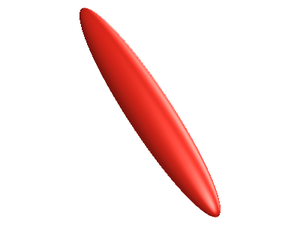Hard ellipsoid model: Difference between revisions
Jump to navigation
Jump to search
Carl McBride (talk | contribs) No edit summary |
Carl McBride (talk | contribs) No edit summary |
||
| Line 1: | Line 1: | ||
[[Image:ellipsoid_red.png|thumb|right|A prolate ellipsoid.]] | [[Image:ellipsoid_red.png|thumb|right|A prolate ellipsoid.]] | ||
== Interaction Potential == | |||
The general ellipsoid, also called a triaxial ellipsoid, is a quadratic surface which is given in Cartesian coordinates by | |||
:<math>\frac{x^2}{a^2} + \frac{y^2}{b^2} + \frac{z^2}{c^2} = 1</math> | |||
where <math>a</math>, <math>b </math> and <math>c</math> define the lengths of the | |||
axis. | |||
==References== | ==References== | ||
#[http://arxiv.org/abs/cond-mat/0611360 Carl McBride "Hard biaxial ellipsoids revisited: numerical results", arXiv:cond-mat/0611360 (2006)] | #[http://arxiv.org/abs/cond-mat/0611360 Carl McBride "Hard biaxial ellipsoids revisited: numerical results", arXiv:cond-mat/0611360 (2006)] | ||
[[Category: Models]] | [[Category: Models]] | ||




